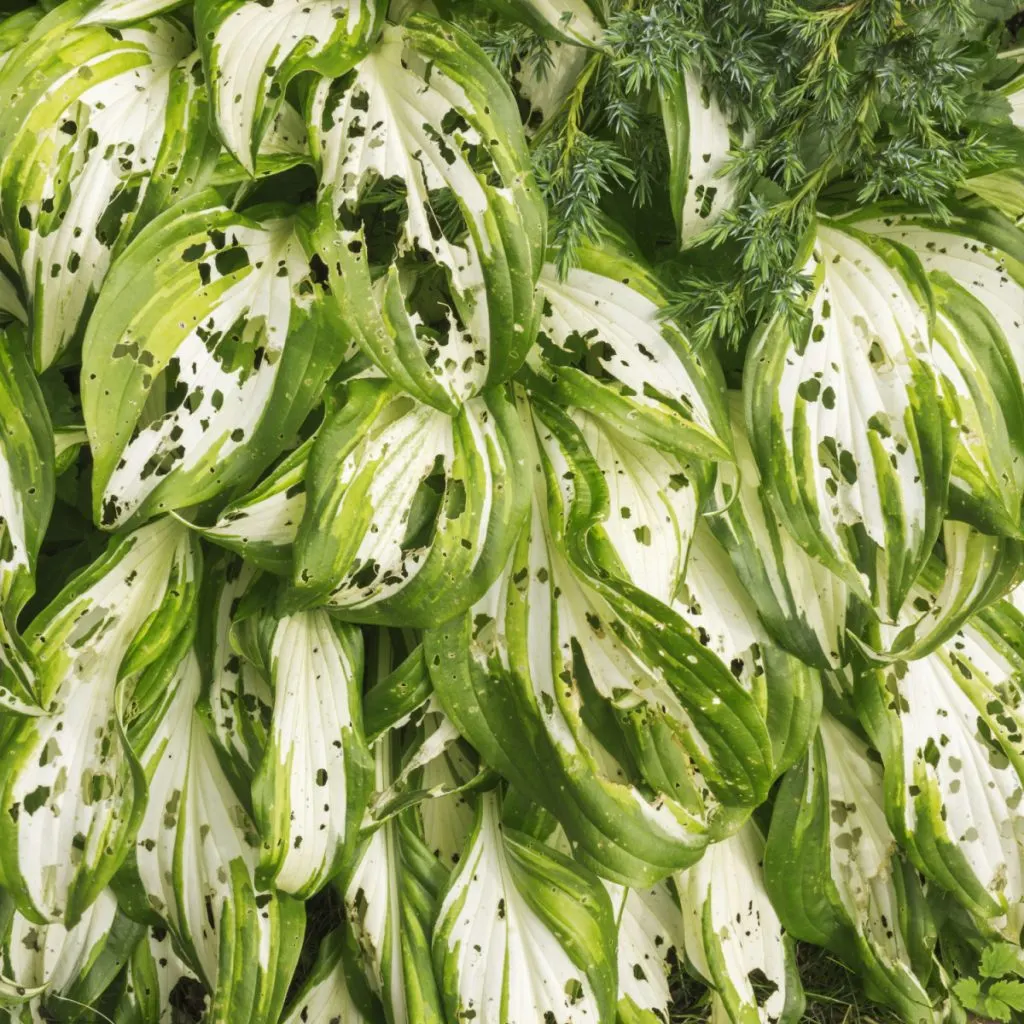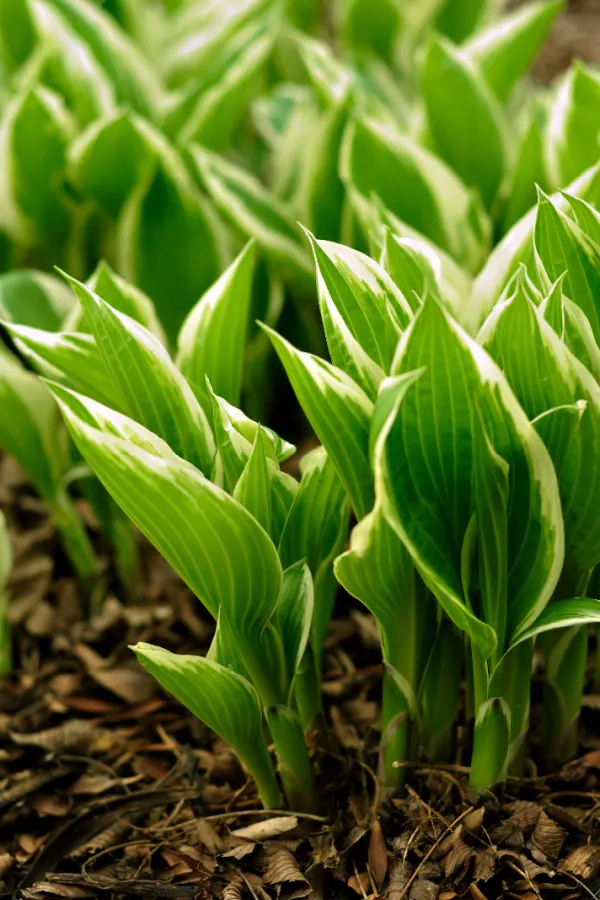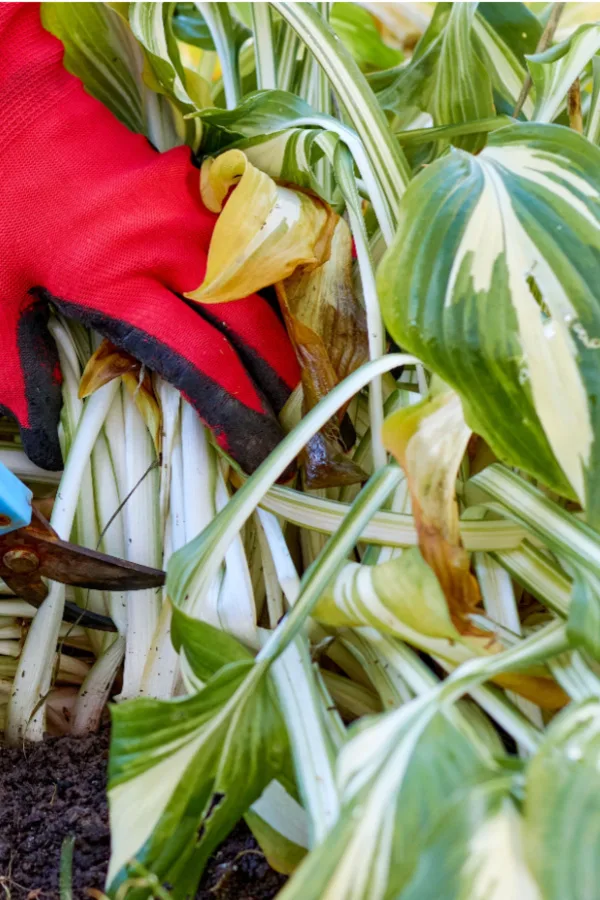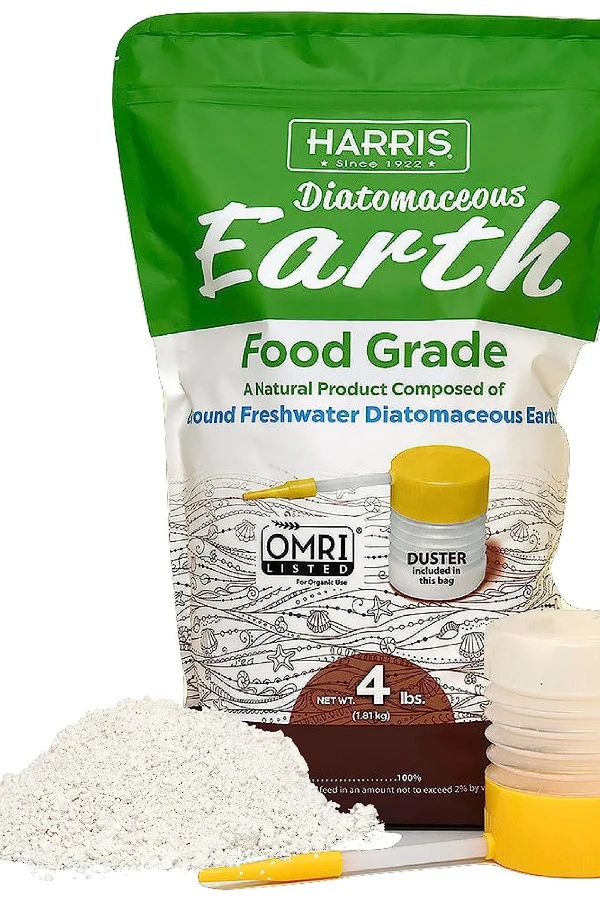Looking for a few simple tricks to keep insects off of your hostas this year – and keep their foliage big, bright and beautiful all spring, summer and fall long?
As beautiful as hostas can be in the landscape, if there is one painful drawback to growing them, it’s trying to keep slugs, beetles, aphids and a whole host of other pests from devouring their leaves. It can certainly be depressing to watch the gorgeous foliage sprout through in early spring, only to be chewed through in short order to look like Swiss cheese.
One of the biggest reasons hostas are a favorite of pests is that their leaves are so soft. And – so plentiful! The tender foliage that sprouts from the earth in early spring is quite easy to digest for pests. In addition, because they are large, the leaves also provide plenty of cover.

That cover is not only good for protection while eating, but also for laying eggs or larva for future generations of pests. In fact, quite often if you see damage on top portion of hosta leaves, by simply turning the leaves over, you will find plenty of new eggs and larva ready to hatch too!
But here is some good news, you can win the fight against insects damaging your hostas! In fact, not only can you help keep your hostas safe with a few of today’s methods and tips, you can also keep nearly all the perennials in your flowerbeds safe from pest attacks. And do so all growing season long!
How To Keep Insects Off Hostas – 4 Simple Tricks To Keep Hostas Safe
The first rule of thumb when trying to keep pests away from your perennials is to be diligent in prevention – and be on the lookout early in the season for the first signs of an invasion!
Unfortunately, once pests begin to multiply, they can damage plants in a hurry. Especially tender hosta leaves. So, more than anything else, check your plants regularly for any issues. The faster you find an issue – the easier it will be to quickly eliminate it.
Now let’s take a look at four simple methods that can deter, protect and even get rid of pests that attack your hostas.

#1 Mulch Around Your Hostas With Sand
Want to prevent a few problems from your hostas right from the start? Use coarse sand! That’s right, by mulching the area around the base of your hosta plants with a few inches of coarse sand, you can help to keep slugs and other crawling insects away – and help your plants in the process!
One mistake many gardeners make with their hostas is to put hardwood or compost mulch right up to their plants. Unfortunately, that can be a haven for slugs and snails to live and hop onto the hostas at ground zero. But a thick, 2 inch layer of coarse sand around the base changes that.
Slugs and snails do not like to crawl across the sharp sand edges. In fact, it can often damage and rip their slimy bodies, killing them in the process. Even better, the sand allows moisture through to the roots when it rains to help keep plants better hydrated.
#2 Protect Your Plants With Cinnamon – How To Keep Insects Off Hostas
Believe it or not, cinnamon can be a great weapon for protecting hosta plants. When your hostas first come through the earth, ring the base with cinnamon powder. Pure cinnamon is actually incredible good for repelling slugs, ants and snails.

And if you happen to see aphids starting to congregate on the leaves of your hostas, cinnamon oil spray will actually kill them off in short order. Even better, that same cinnamon oil won’t just repel slugs and snails, it actually will get rid of them for good too! See our article: How To Use Cinnamon To Repel Pests In Gardens & Flowerbeds
#3 Diatomaceous Earth – How To Keep Insects Off Hostas
If sand and cinnamon are first steps to prevention, diatomaceous earth can handle the rest! One of the best ways of all to safely and effectively prevent and/or control an outbreak of insects in your flowerbeds is with diatomaceous Earth.
Diatomaceous earth is a powder that consists of fossilized algae. Often referred to as (DE), it is all natural but has extremely sharp microscopic edges that kill a long list of common pests. But, at the same time, it’s harmless and non-toxic to pets and humans!
It can be applied right on the foliage of plants and will both kill existing pests, and any that land on it later. It is best to put this on early in the morning or late in the day to avoid directly dusting bees and other pollinators.
Having a bag of diatomaceous earth on hand can be a lifesaver for your hostas. In fact, it can be so for a long list of other perennials, annuals and vegetable plants as well! Affiliate Product Link: Diatomaceous Earth With Powder Duster, Food Grade
#4 Neem Oil – How To Keep Insects Off Hostas
Another great all natural insecticide for hostas is neem oil. And it is highly effective in controlling aphids, cutworms, beetles, caterpillars and more. Even better, it can do so very fast!
As long as you are taking stock of your flowerbeds on a regular basis and finding problems when they first appear, neem oil can make quick work of keeping your hostas healthy and strong. Affiliate Product Link: Captain Jack’s Neem Max, 8 oz Concentrated Cold Pressed Neem Oil
Much as with DE, it’s best to spray neem oil in the early morning or late evening. It will not harm butterflies, bees and other pollinators once it dries, but it can if it hits them directly. When spraying, always be sure to turn up and hit the underside of leaves where many insects like to hide.
Reviving Damaged Hostas – How To Keep Insects Off Hostas
Sometimes, a pest invasion is missed – and the pests get to your hostas. But don’t despair, it’s actually quite easy to revive them, even during the middle of a growing season.

If you hosta’s foliage is beyond repair, simply take a pair of hedge trimmers and prune them back. You can cut right to ground level. This can be done at any point from spring to fall. And as long as you still have a few weeks of warm weather left, your hostas will sprout fresh new, unblemished foliage to enjoy. It really is that easy!
Here is to keep your hostas safe, healthy and beautiful from pests and insects all spring, summer and fall.
Simple Garden Life
Follow Our Facebook Page For Even More Great Tips! Simple Garden Life Facebook Page
Simple Garden Life is a website dedicated to keeping gardening fun, simple and enjoyable! We publish two new articles each week along with a new garden podcast episode every two weeks. This article may contain affiliate links.

